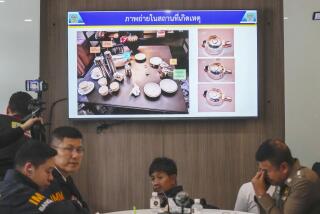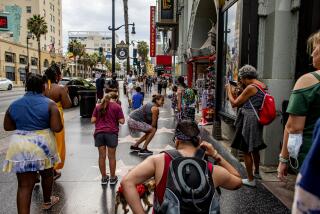Country’s Hotels Put Out the ‘Vacancy’ Sign
HANOI — New hotels are sprouting here like mushrooms. A Hilton is under construction. So is a Sheraton. There’s talk of a Marriott. Six other luxurious international hotels are nearing completion.
But with tourism dropping--particularly here in Vietnam’s capital and one of Asia’s loveliest cities--tourist industry officials are starting to ask: Who’s going to fill all these rooms?
After a brief flirtation as Asia’s newest “in” tourist destination a few years ago, Vietnam’s room-occupancy rate has plummeted, to 52% in Hanoi and 48% in Ho Chi Minh City (formerly Saigon).
Hanoi attracted only 143,000 tourists in the first six months of 1997; for a projected full year, that’s 30% below the city’s target, Hanoi tourism officials said.
Vietnam Airlines, the national carrier, saw its passenger loads increase by only 7% in the first seven months of this year, after annual increases of up to 42% from 1993 to 1996.
Some small hotels have cut their rates in half, to about $20 a night, though luxury hotels still average around $150, cheap by Southeast Asian standards.
The government has responded by ordering a construction ban in Hanoi on mini-hotels with 20 or fewer rooms. It is considering extending the ban to other cities. It also has set up staff-training programs at state-owned hotels in order to improve service.
At the heart of Vietnam’s attempt to tap into the lucrative tourist industry enjoyed by Thailand, Singapore, Malaysia and most Southeast Asian countries, lies the history of the past. After a generation of warfare and the dark years of isolation from 1975 to the start of an open-market economy in 1986, Vietnam started at zero, with neither tourists nor a tourist industry nor a tourist infrastructure.
Vietnam has since made remarkable progress. The number of foreign visitors grew from 300,000 in 1991 to 1.6 million last year, and the lackadaisical service that characterized the socialist period has been replaced by service so genuinely gracious that visitors might be excused for feeling the need to encounter a surly New York waiter to return to reality.
But Vietnam remains hampered by the absences of a global marketing campaign--a luxury it cannot afford--and a strategy to target the type of tourists it wants to attract.
The vanguard of the country’s Western tourist trade was made up of backpackers who traveled Vietnam on the cheap. More recent visitors have included former U.S. service members and well-heeled European and American travelers for whom Vietnam remains an exotic, as-yet-undiscovered destination.
“You can safely say Vietnam has a huge tourist potential,” said Sarah Grant of Hanoi’s five-star Sofitel Metropole hotel.
“Vietnam has lovely cities, friendly, energetic people--and brand-name recognition because of the war, which may sound horrible to say but is undeniably true,” Grant continued. “Right now, I think, the industry is in transition. We’ve moved beyond the backpackers and real adventurers who were the first to come, but there’s not yet enough to offer the large mainstream of the tourist industry.”
Certainly no one disputes Grant’s contention that Vietnam has potential. Its beaches, pristine and deserted for countless miles, are among Asia’s finest. Its cities are full of the romantic mystique popularized by Graham Greene. Its central highlands have the mountainous beauty of New England. It has a rich history and a vibrant culture.
“Within 10 years, this will be another Bali,” said Paul Stoll, general manager of the just-opened $40-million Furama, Vietnam’s first five-star resort. Located on China Beach in Da Nang, three miles from the former Marine R&R; complex popularized in a television series, it stands on property once occupied by the post exchange of a Marine helicopter base.
“Well-traveled tourists have been to Thailand,” Stoll went on. “They’ve been to the Philippines and Bali. They’re looking for new destinations and Vietnam has it all. The fact that Hanoi has too many hotels and isn’t in tune with the tourist industry is common in most pioneering marketing environments. It happened in Bangkok too.
“People discover a place,” Stoll noted. “There are too few rooms. A lot of new hotels go up. At first you can’t fill the rooms. But eventually the demand and the infrastructure catch up and a solid tourist industry evolves.”
In traditional terms, Vietnam’s tourist arrivals are less than officially reported. The government says that the largest number of tourists--32% of the total--come from China. But many of those visitors merely cross over Vietnam’s northern border for a few hours of shopping.
The nation’s building boom is a result of hotel projects coming on line from 1992 and 1993 when Western and Asian investors were captivated by the newly opened market economy. Anticipation of the Francophone summit that will be in Hanoi in November, which is expected to attract 50 heads of state, has also been a factor.
(BEGIN TEXT OF INFOBOX / INFOGRAPHIC)
Visitors to Vietnam
FOREIGN TOURISTS
1996: 1.6 million
****
WHERE THEY COME FROM
China: 32%
Overseas Vietnamese*: 12%
Taiwan: 11%
Cambodia: 9%
Japan: 7%
France: 5%
U.S.: 3%
Britain: 3%
* Vietnamese with other citizenship, mostly American, French and Australian
Source: Hanoi Tourism Office
More to Read
Sign up for The Wild
We’ll help you find the best places to hike, bike and run, as well as the perfect silent spots for meditation and yoga.
You may occasionally receive promotional content from the Los Angeles Times.






